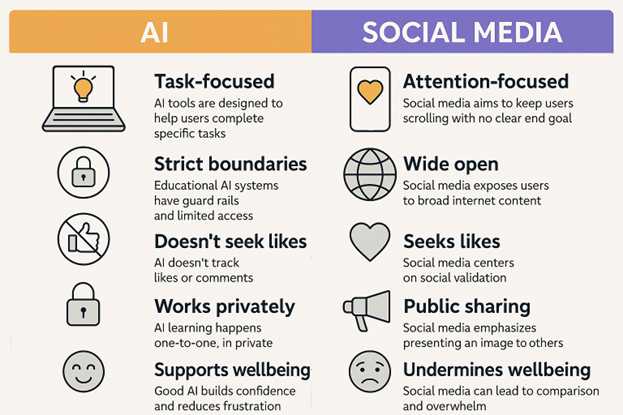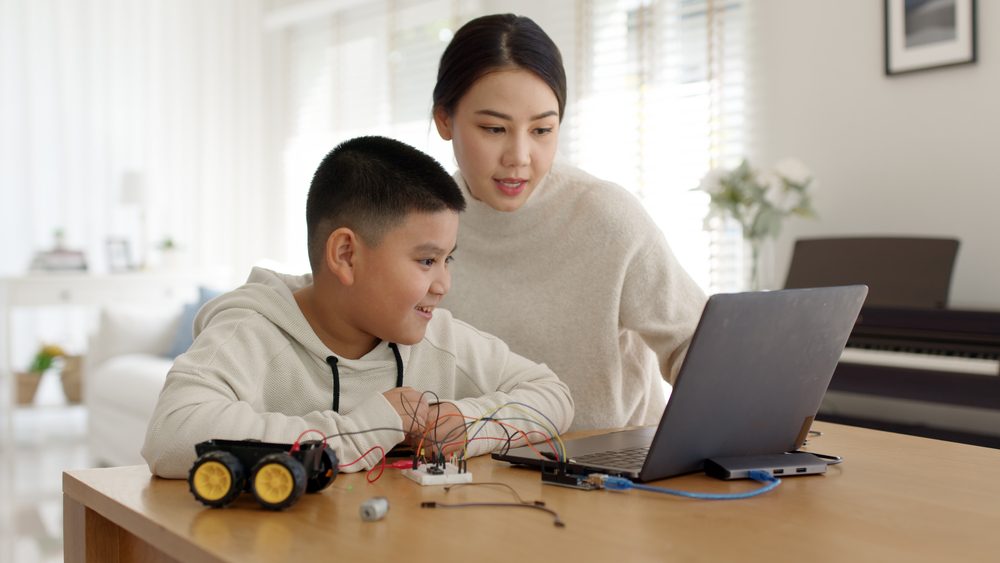Let’s tackle the worry first
You’ve probably heard the headlines: students using AI to write their homework, AI giving dodgy answers, or kids relying on it too much. And yes – those things can happen. But not all AI tools are the same.
The kind of AI that schools and responsible platforms use has guard rails –boundaries that prevent misuse. It’s a world away from social media, where anything goes.
On our own site, for example, AI is limited to individual subjects and is only there to help explain quiz questions, not do the work for students.
Safe AI is NOT Social Media
There are loads of online platforms out there for children – and many look pretty similar at first glance. It’s easy to think they all work the same way, with the same risks and benefits. But they don’t. Let’s take a quick look at what makes AI different to social media…
- AI is task-focused – social media is attention-focused – AI tools (like tutors or revision aids) are designed to help users complete a task – such as answering a question, learning a concept, or improving a skill.Social media platforms, on the other hand, are designed to keep users scrolling, often with no clear end goal.
- AI can have strict boundaries – social media is wide open – Educational AI systems (like the one on Education Quizzes) are restricted to specific topics, with clear guard rails and no access to broader internet content. Social media is unfiltered and often unpredictable, exposing users (especially children) to misinformation, ads, or harmful content.
- AI doesn’t seek likes or followers – AI doesn’t care if it’s popular – it doesn’t track likes, views, or comments. Social media is built around social validation, which can impact children’s confidence, concentration, and even mental health.
- AI works privately – social media thrives on public sharing – AI learning happens one-to-one, in private. Students can make mistakes without embarrassment. Social media is highly public, with constant pressure to present a certain image or keep up with others.
- AI can support wellbeing – social media often undermines it – When well-designed, AI can build confidence, adapt to a learner’s pace, and reduce frustration. Social media often leads to comparison, distraction, and overwhelm – not helpful for learning.
- AI is a tool – social media is an environment – AI is something you use. Social media is somewhere you can get stuck. Good AI helps learners focus, while social media often pulls attention in a dozen different directions.

AI Tutoring at home vs. Classroom Teaching: What’s the Difference?
Both have their place – but they work in different ways, and each offers something unique.
- One-to-One vs. One-to-Many – AI tutors give focused, one-to-one support. Classrooms have one teacher for many students, which can make personalised help harder.
- Anytime Help vs. Timetabled Lessons – AI is available 24/7. Classroom help is tied to the school day.
- Learn at Your Own Pace – AI lets children go over things as often as needed. In class, they have to keep up with the group.
- Private vs. Personal – AI gives quiet, pressure-free support. Teachers offer encouragement, emotional support, and real-world connection.
- Best When They Work Together – AI doesn’t replace teachers – it backs them up. It helps reinforce what’s taught in class, builds confidence, and fills in gaps.

How to Use AI Positively at Home
You don’t need to be a tech expert to make the most of AI with your child – just a little guidance goes a long way. Here are a few simple, sensible ways to support learning at home:
- Use AI as a helper, not a crutch – Encourage your child to try things first on their own – then use AI to explain tricky bits or check understanding. It’s not about getting answers; it’s about building confidence.
- Keep things focused – Stick to trusted platforms with clear goals – like revision, quizzes, or subject-specific support. Avoid open-ended AI chatbots unless you’re sure they have guard rails in place.
- Talk about what they’re learning – Ask your child to explain how the AI helped them. If they can teach it back to you, they’ve understood it – and it builds great communication skills too.
- Make it part of a routine – Short, regular sessions with an AI tutor or quiz tool can be more effective than last-minute cramming. A few minutes a day can make a big difference.
- Keep it safe and age-appropriate – Choose tools designed for children. Look for those that focus on learning, not entertainment – and always check privacy settings if it connects to the internet.
Make it Fun!

When learning feels fun, it sticks. Encourage children to explore topics in playful ways, such as:
- Asking AI to explain things differently
- Requesting a joke or limerick on the topic
- Saying, “Can you give me an example?”
- Trying, “Can you explain it like I’m five?”
- Requesting a weird or surprising fact
Exploring topics creatively helps children stay curious, ask better questions, and build real understanding. Whether it’s through humour, simple explanations, or fun facts, AI can turn learning into an adventure – one that feels more like play than work.
Written by Colin King, co-founder and owner of Education Quizzes – a UK-based platform offering teacher-written revision quizzes that have built-in Safe AI Tutoring.

